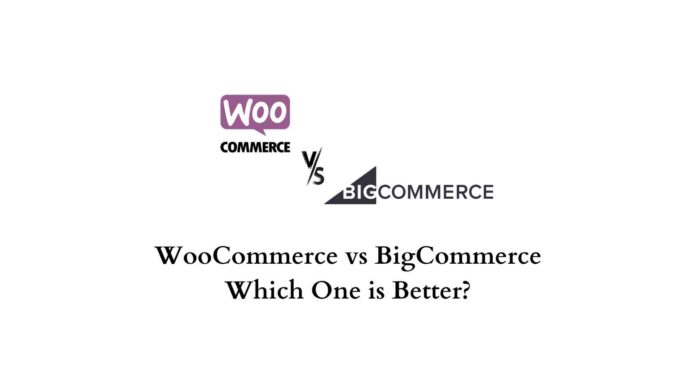Last updated - November 20, 2023
When setting up online stores, there are a wide range of factors to consider. One of the most pressing and significant decisions is which platform to build your eCommerce operation on.
One common debate is Woocommerce vs Bigcommerce. The situation can be clouded as there are firm adherents to each. So, depending on who you talk to, you might end up with one or the other.
But how do you know which is right for your business and needs? This article will dive into the key differentiating factors and features of each. But first, let’s explore what eCommerce platforms need to deliver.
What to Look for in an eCommerce Platform
Whichever eCommerce platform you go for, whether Bigcommerce, Woocommerce, or something else altogether like Shopify, consider the following features:


- Is it a user-friendly interface? You don’t want a platform you have to wrestle with every time you use it. You need a user-friendly interface with a degree of intuitiveness. This way, you can master it in relatively little time, even with few technical skills to boast of.
- Does it offer suitable payment gateways? Your eCommerce platform needs to support the payment forms you want on your site. Generally speaking, the more you offer, the more enticing it is for customers to make a purchase. Being more flexible means securing more sales.
- Is it a scalable platform? There’s no sense in having a rapid growth business if your eCommerce platform is stuck in the slow lane.
- Will you receive support? When trouble hits, you want to ensure your sales operation suffers minimal disruption.
- Is it affordable? It’s unlikely you’ll have an enormous amount of capital to plow into a project. The last thing you want is to saddle an early-stage company with a vast debt that you spend your initial hard-earned income paying off.
- What additional features can you leverage? You may need additional features to suit your operation, such as gift cards, marketing tools, invoice management, shipping handling, SEO, customer churn measurement tools, and so on.
Make sure you have a list of what you need before going platform shopping.
What is WooCommerce?


We’ll start with the big one in the BigCommerce vs WooCommerce face-off.
WooCommerce is a hugely popular choice and the most popular eCommerce plugin for WordPress. In fact, research suggests that WooCommerce takes up over 38% of the total eCommerce market share.
Why has there been such widespread uptake of this open-source plugin? The most likely reason is that using WooCommerce to convert any WordPress blog or other site to an eCommerce site is fairly straightforward.
Another key reason for WooCommerce’s popularity is that it enables a site owner to do everything on one WordPress platform. You can blog, manage, and conduct eCommerce operations in one place.
What is BigCommerce?
This platform has yet to make such inroads into the market as WooCommerce. But it’s starting to show signs of catching up.
It differs from WooCommerce in several ways. Crucially, it’s not a plugin but a fully hosted SaaS eCommerce platform. Think of it as a website builder where you can create an eCommerce site from scratch.
This means you enjoy high levels of flexibility. You can fashion the site to encompass whatever you envisage your eCommerce operation to look like, including remote and in-person sales.
WooCommerce vs BigCommerce: 6 Key Differences
Now that you have an understanding of the basic differences between these two popular eCommerce platforms, let’s look at the pros and cons of each in more detail. Let’s kick off the WooCommerce vs BigCommerce debate!
- Ease of Use


In general, an all-in-one solution SaaS platform like BigCommerce is easy to use, assuming little expertise on the user’s part. With BigCommerce, in particular, the onboarding process is excellent, with a detailed but digestible tour introducing its features.
Terminology can be tricky for beginners to become fluent with. But once you master these, you can leverage powerful features to start building. Plus, there’s no need for any coding knowledge or much technical expertise.
However, if you’re used to WordPress, you may find that WooCommerce is easier to get your head around. It uses the dashboard you’re accustomed to so you’ll likely get to grips with it more quickly.
WooCommerce’s onboarding is even more straightforward than that of BigCommerce. For instance, it employs a very user-friendly setup wizard.
That said, BigCommerce gives you everything – hosting, security certificates, and domain names, whether you’re looking for a top-level domain .hk or a good old .com. With WooCommerce, however, you need to sort this out yourself.
- Payment Gateways
BigCommerce comes with an impressive array of digital wallet payment channels built-in. These include PayPal, Amazon Pay, Apple Pay, Square, Stripe, and CyberSource.
On the other hand, WooCommerce offers PayPal and Stripe by default. But you can choose from over 100 different payment options as extensions and add-ons.
Both companies will handle major credit cards and debit cards for a transaction fee levied by the card companies and not BigCommerce or WooCommerce themselves.
- Scalability
Being a SaaS provider, BigCommerce is a pre-eminently scalable platform that will automatically adapt to your business as it grows. Storage and processing are all handled in the cloud so you don’t have to think about them. Plus, different service levels are available should you need to ramp up what’s on offer.
WooCommerce, on the other hand, asks you to be responsible for factors like storage and security. So it’s up to you to make ongoing decisions on what your business needs. You can upscale for sure. But it might be slightly confusing and time-consuming to handle this side of things if you don’t have prior expertise in the area.
- Support


It’s possible to get great support for both platforms. BigCommerce provides 24/7 support via telephone, email, and live chat, as well as a huge community user forum and help center. The latest developments are posted on the BigCommerce blog, so you can always stay up to date.
WooCommerce doesn’t offer this amount of support. It does provide pretty comprehensive guides and a vast user community but little formal provision.
However, it’s possible to get excellent support from your host service, depending on which one you choose. For instance, Bluehost offers great WordPress-focused support that is on par with the help offered by BigCommerce. So, choose your host wisely.
- Affordability
It’s easy to think that because WooCommerce is open source, it must be the cheaper option as it’s free. However, there are additional costs that need to be built into your calculations.
You will need to pay for hosting plans, whether you’re looking at an .ai domain or something nearer to home. You should also factor in SSL certificates, which could amount to a total outlay in the region of $150-$200 per annum.
Against this, BigCommerce offers a subscription basis, enabling you to choose between three pricing plans. The standard level costs $29.95 per month. This is all in, so your basic eCommerce site costs are covered. This level of service comes to a yearly cost of approximately $360, making it more expensive than WooCommerce.
- Extras
In terms of online business add-ons and plugins, WooCommerce is the clear winner, as this is what the platform’s all about.
You select what you need from the virtually unlimited product range and plug it in – whether it’s quality blogging features, marketing features, cart recovery tools, or premium themes. Advanced features and WordPress themes abound, so you’re likely to find something to suit your needs.
That’s not to say that BigCommerce is feature-poor. It has an impressive range of built-in features and does offer a decent collection of third-party apps and integrations, so you can find most, if not all, of what you need.
The Verdict


Put starkly, in the WooCommerce vs BigCommerce bout, it looks like this. WooCommerce is, by a tiny margin, easier to use. With payment options, BigCommerce offers more in the first place, but WooCommerce offers a more extensive plugin range.
Scalability and support are wins for BigCommerce. Its SaaS character means that BigCommerce users are well looked after by a service that takes most stress away from business owners.
WooCommerce is likely to be cheaper than the cheapest BigCommerce option. Unless, that is, you’re using a particularly expensive hosting service. Finally, WooCommerce triumphs in the extra features realm, being basically designed as a platform you add features to.
WooCommerce edges it in most of the eCommerce platform categories. It’s down to the business owner to decide how much they want to handle themselves and how much they might value having some stresses spirited away into the cloud. But, if you’re up for the ride of doing it yourself, then WooCommerce is a better bet.
At the end of the day, whichever eCommerce platform you choose, you’ll likely reap the benefits. But take time to identify your needs and analyze the features we’ve compared above. This way, your online store will be primed for success from the get-go.











